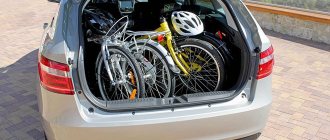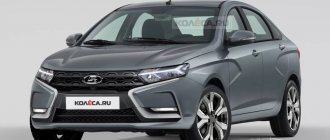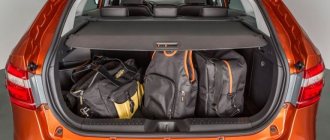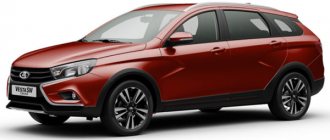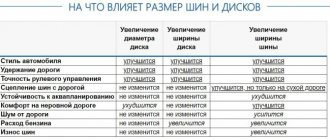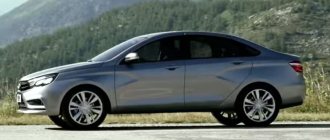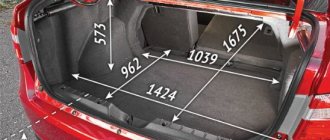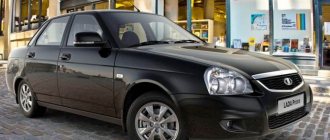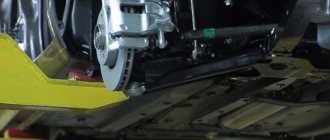Lada Vesta SW Cross is the flagship among all cars produced at the plant. This model went on sale in the fall of last 2022. Like all other cars, before starting production, Vesta Cross underwent testing of safety systems. The Lada Vesta Cross crash test was carried out according to the Euro NCAP system, which is particularly strict. In total, using this method, the tested car can score 5 stars.
The crash test of the Lada Vesta SV Cross according to the Euro NCAP system brought the model 4 stars, which is a very good result. I would also like to note that Vesta underwent crash tests according to the standards of 2008, but even for these rules the result is very good. Since 2016, Euro NCAP rules have become significantly stricter. Therefore, it is difficult to say whether Vesta Cross will show the same result now.
The safety of Vesta Cross, although not at the maximum level, is quite acceptable. All this was achieved not only by the correct design of the body, but also thanks to the equipment of Vesta already in the basic configuration, which has two airbags for the driver and passenger, as well as ABS and ESC systems.
Pre-production tests
As you know, even before the start of serial production, comprehensive tests were carried out, which took place in May 2022. One of the stages of testing was caught by an analyst from the authoritative publication Autoreview.
Below are the design features of the car body.
On that day, the crash test of the Lada Vesta Cross SW involved a side impact with a ram weighing 900 kg with a crushable tip at a speed of 50 km/h. In this case, the “test” was a car with the maximum configuration, “armed” with 4 airbags.
Side impact
The results did not make the AvtoVAZ designers blush with shame. Vice versa! The car showed a decent result. The threshold absorbed a significant portion of the energy during the impact, the side airbags worked as they should, and only the driver's window broke - the rear window remained intact.
According to information from AvtoVAZ reports, it became clear that the sensors attached to the dummy did not indicate excessive loads, and the HIC (head injury) standard showed an excellent result of 21.8 units.
Condition of the dummy after the impact
However, an expert from Autoreview noticed one interesting fact - AvtoVAZ did not test the cross-version of the station wagon with a loaded trunk, although such a test suggests itself. The same applies to security systems that would allow securely securing large luggage that is located above the window line.
The plant commented on its decision, explaining it by the purpose of the machine itself. According to company representatives, a crash test of the Lada Vesta Cross station wagon was not carried out in such conditions, since this is only a lifestyle model with increased cross-country ability, and not a vehicle for transporting cargo.
No less interesting is the plant’s decision to refuse to equip the car with rear side airbags - even in top versions there are only front ones. In this case, the reason was that the presence of such airbags in itself (without the corresponding active safety systems) will not in any way affect the final rating during testing according to EU criteria. Although many are sure that buyers of top trim levels would agree to pay a little extra for additional protection for rear passengers.
The LADA Vesta Cross station wagon does not have rear side airbags even in the top
Lada Vesta Cross safety level
If we evaluate the test result according to the criteria of the Russian plant with child dummies, then it turned out to be simply excellent. There are no floor breaks at the welding points, the thresholds are not swollen or broken. Experts were able to prove that the unsuccessful scores obtained in the external test were due to the fault of Autoreview representatives. The use of twenty-kilogram ingots affected the final results, as they increased the load on the floors. When testing at AVTOVAZ, Vesta SW Cross was able to receive not only 14.9 points, but also a maximum of 4 stars. The car has high safety scores, more than the Lada Kalina, which scored only 10.1 points, and the Grant with a score of 10.7 points.
Related link:
What you need to know about the new manual transmission on the Lada Vesta
Tests of the serial version
After the start of sales, crash tests were carried out on the Lada Vesta Cross station wagon of the production model. First, let's look at the frontal strike, which was carried out by Autoreview forces directly using their ARCAP method. And then we will evaluate the results of the side impact carried out at AvtoVAZ.
The need for repeated tests of the full cycle, in comparison with a conventional station wagon, is due to the increased ground clearance and increased weight of the Cross.
Autoreview compiled its own ARCAP rating
Prices for all LADA cars
| 4×4On sale | from 559,900 rub. |
| 4x4 5 doors On sale | from 602,900 rub. |
| 4x4 BrontoOn sale | from 742,900 rub. |
| 4×4 UrbanOn sale | from 635,900 rub. |
| 4×4 Urban 5 doorsOn sale | from 678,900 rub. |
| NivaOn sale | will appear later |
| XRAYOn sale | from 626,900 rub. |
| XRAY CrossOn sale | from 776,900 rub. |
| GrantaOn sale | from 460,900 rub. |
| Granta Drive ActiveOn sale | from 645,900 rub. |
| VestaOn sale | from 636,900 rub. |
| Vesta CrossOn sale | from 783,900 rub. |
| Vesta SportOn sale | from 1,049,900 rub. |
| Granta SportArchive | from 554,900 rub. |
| PrioraArchive | from 424,900 rub. |
| Granta CrossOn sale | from 579,900 rub. |
| Granta Station WagonOn sale | from 487,900 rub. |
| LargusOn sale | from 622,900 rub. |
| Largus CrossOn sale | from 782,900 rub. |
| Vesta SWOn sale | from 715,900 rub. |
| Vesta SW CrossOn sale | from 822,900 rub. |
| Kalina UniversalArchive | from 475,200 rub. |
| Priora UniversalArchive | from 443,000 rub. |
| Largus VanOn Sale | from 596,900 rub. |
| Granta LiftbackOn sale | from 478,900 rub. |
| Granta HatchbackOn sale | from 477,900 rub. |
| KalinaArchive | from 460,600 rub. |
| Kalina CrossArchive | from 545,800 rub. |
| Kalina SportArchive | from 576,900 rub. |
| Priora HatchbackArchive | from 443,000 rub. |
Frontal kick
By the way, the journalists themselves noted that the choice of this particular model was predetermined by readers, who gave many votes for this option - more than for Renault Captur, Hyundai Creta and Toyota Camry together. As a result, the car was purchased and destroyed for 797,900 rubles. Frontal impact on a deformable ceiling at a speed of 64 km/h.
Before the test, experts immediately noted the large wheels, because the Cross station wagon has 17-inch wheels at the top, versus 15-inch wheels on the sedan. In addition, weight measurements were carried out, and it turned out that the car is 148 kg heavier than the sedan - 1298 kg versus 1150 kg, respectively. Therefore, it must absorb 13% more energy (kinetic).
Naturally, specialists from AvtoVAZ were invited to crash test the LADA Vesta Cross station wagon.
Structurally, the Cross version is identical to a simple station wagon. However, compared to the sedan there are changes:
- Additional reinforcement in the A-pillars - this reinforcement extends to the center of the doorway.
- The thresholds have been strengthened.
All details of the tests are demonstrated in the video.
It is worth noting that the ERA-GLONASS service worked perfectly, and after the impact the operator immediately contacted the car.
As for the results of the impact, at first glance, the car withstood it just fine! The front pillar remained in its place (apparently, the presence of an additional amplifier had an effect). In addition, the spar on the left side worked perfectly - it folded, absorbing most of the impact energy, whereas on the sedan this power element simply bent. In addition, part of the energy fell on the cast wheel disk, which cracked from the impact.
The driver's door opened with minimal effort, the airbags worked effectively, which can also be credited to the carriage.
The driver's door opened easily
Next, the experts began assessing the condition of the front passengers who remained alive.
- Head and neck - everything is within normal limits. Only the driver turned his head when the car bounced, but this does not threaten his health.
- Chest - no complaints about the belt, since the force of compression of the ribs is completely normal and even weaker than on a sedan. It is very important that upon impact the steering wheel moved away from the driver by 30 mm.
- Knees - the right knee hit the dashboard slightly, while the left did not touch the plastic at all.
- Feet - despite the slight displacement of the pedal assembly, nothing dangerous happened.
Consequently, at first glance, the crash test of the LADA Vesta Cross station wagon during a frontal impact passed at the highest level and the car is worthy of the highest rating. However, everything is not so smooth...
The fact is that in Europe they use a much more progressive assessment methodology and if you apply it, the results will not be so rosy. During testing using the Euro NCAP system, the “structural integrity of the passenger compartment cage” is also assessed.
If you remove the decorative plastic that covers the sills and fenders, metal creases on the rear and front sills will become noticeable. The situation with the front threshold is especially important, because this area was modified and strengthened by the plant in 2016 - thicker metal was used.
After Autoreview employees cut the threshold and removed the outer trim, it became clear that not only it was deformed, but also the power element itself.
Also, the floors and floor sound insulation were removed from the station wagon. In this situation, the picture is the same - the floor is torn and crushed, which is defined as “destruction of the legroom” and means one point is deducted from the assessment. Moreover, the welding survived - breaks appeared around the points. Therefore, AvtoVAZ should pay attention to the quality of sheet metal supplied to the plant.
The situation with the driver’s legs also became more complicated. The floor heaved up and created unnecessary stress on the legs - according to the result, the rating was not “excellent” or even “good”, but only “satisfactory”.
All this significantly reduced the score in the category “Protection of the lower legs” - according to the crash test results of the Lada Vesta Cross station wagon, the car scored only 1.7 points out of the maximum 4 points.
The deformation of the threshold also deducted 1 point from the final score, because according to the Euro NCAP system this is regarded as a “violation of the stability of the doorway.”
In addition, due to the break in the threshold, AvtoVAZ lost the opportunity to apply the “Front Panel Safety” protocol. During testing, the dummy slightly hit his left knee on the plastic of the steering column. This is not dangerous at all, but is made worse by the fact that there are metal components underneath the plastic. As a result, another point was removed from the assessment.
This could have been avoided if not for the damage to the threshold, which provoked a violation of the “structural integrity of the passenger cabin cage.” Under this condition, AvtoVAZ failed to ensure the safety of the structure, and a fine for knees was imposed.
The final score is 11.7 points out of a possible 16, and only 3 stars.
Plant reaction
This result greatly puzzled AvtoVAZ engineers. As a result, the car company bought the car that was broken during the test and thoroughly examined it. At first there were suspicions of a defect during assembly, but this version was not confirmed.
Everything became clear after computer modeling, when the data obtained was compared with tests that were carried out directly at AvtoVAZ and then gave a much better result. The reason is the ballast.
Any car is prepared for a crash test according to a certain algorithm. It means:
- Front seats - 88 kg each (dummies);
- Rear sofa - 32 kg (ballast);
- Trunk - 36 kg (weight necessary for testing equipment);
- Gas tank – 90% full (water is used).
During tests at AvtoVAZ, 2 child seats with Isofix mounts and a pair of child dummies were used as ballast for the rear sofa. But in Autoreview they used ordinary metal ingots, screwed to the floor, weighing 20 kg. This approach is permitted by the Euro NCAP criteria, provided that it does not affect the result. And it is worth noting that during other tests (Vesta sedan, Volkswagen Polo, Hyundai Solaris), the same ballast was used (blanks on the floor) and it did not affect the final rating in any way.
This fact is best proven by the fact that all tests were attended by representatives of the company that produced the car (Hyundai, Volkswagen, AvtoVAZ) and there were no complaints.
After creating a mathematical model, it became clear that 2 metal ingots, weighing 20 kg each, increase the load on the reinforcements and welds by 20%, resulting in floor deformation.
When this fact came to light, AvtoVAZ conducted 2 more similar tests with metal ingots near the rear sofa and the result was exactly the same as that of Autoreview. During the third test, there were child dummies on the back seat. As a result, the crash test of the Lada Vesta Cross station wagon went as well as possible - the belts worked in the required mode, no folds on the floor, metal tears or welding.
If we consider this situation, then out of the maximum possible 16 points, Vesta no longer received 11.7, but 14.9 points!
As for AvtoVAZ, its designers have already carried out calculations and figured out how to make the Cross station wagon stronger in order to avoid floor breaks.
LADA Vesta specifications and prices
Select a package to view the basic and additional equipment that is included in it.
- Vesta
- Vesta Cross
- Vesta SW
- Vesta SW Cross
- Vesta Sport
| Equipment | Body | Engine | Power | Box | Drive unit | Overclocking | Speed | Consumption | Price |
| Classic | gasoline 1.6 l. | 106 hp | M.T. | Front | 11.2 sec. | 182 km/h. | 9.3 | 5.5 | 6.9 | 667 900 | |
| Classic Start | gasoline 1.6 l. | 106 hp | M.T. | Front | 11.2 sec. | 182 km/h. | 9.3 | 5.5 | 6.9 | 704 900 | |
| Comfort | gasoline 1.6 l. | 106 hp | M.T. | Front | 11.2 sec. | 182 km/h. | 9.3 | 5.5 | 6.9 | 735 900 | |
| Comfort Winter | gasoline 1.6 l. | 106 hp | M.T. | Front | 11.2 sec. | 182 km/h. | 9.3 | 5.5 | 6.9 | 771 900 | |
| Comfort Multimedia | gasoline 1.6 l. | 106 hp | M.T. | Front | 11.2 sec. | 182 km/h. | 9.3 | 5.5 | 6.9 | 779 900 | |
| Luxe | gasoline 1.6 l. | 106 hp | M.T. | Front | 11.2 sec. | 182 km/h. | 9.3 | 5.5 | 6.9 | 797 900 | |
| Classic Start Plus | gasoline 1.6 l. | 113 hp | CVT | Front | 11.3 sec. | 175 km/h. | 9.2 | 5.9 | 7.1 | 799 900 | |
| Comfort Winter | gasoline 1.8 l. | 122 hp | M.T. | Front | 10.2 sec. | 186 km/h. | 9.5 | 6.2 | 7.4 | 806 900 | |
| Comfort | gasoline 1.6 l. | 113 hp | CVT | Front | 11.3 sec. | 175 km/h. | 9.2 | 5.9 | 7.1 | 830 900 | |
| Luxe | gasoline 1.8 l. | 122 hp | M.T. | Front | 10.2 sec. | 186 km/h. | 9.5 | 6.2 | 7.4 | 832 900 | |
| Luxe Multimedia | gasoline 1.6 l. | 106 hp | M.T. | Front | 11.2 sec. | 182 km/h. | 9.3 | 5.5 | 6.9 | 838 900 | |
| Luxe Prestige | gasoline 1.6 l. | 106 hp | M.T. | Front | 11.2 sec. | 182 km/h. | 9.3 | 5.5 | 6.9 | 860 900 | |
| Comfort Winter | gasoline 1.6 l. | 113 hp | CVT | Front | 11.3 sec. | 175 km/h. | 9.2 | 5.9 | 7.1 | 866 900 | |
| Luxe Multimedia | gasoline 1.8 l. | 122 hp | M.T. | Front | 10.2 sec. | 186 km/h. | 9.5 | 6.2 | 7.4 | 873 900 | |
| Classic Start | n.d. 1.6 l. | 106 hp | M.T. | Front | 12.9 sec. | 170 km/h. | 8.1 | 5.2 | 6.3 | 874 900 | |
| Comfort Multimedia | gasoline 1.6 l. | 113 hp | CVT | Front | 11.3 sec. | 175 km/h. | 9.2 | 5.9 | 7.1 | 874 900 | |
| Luxe | gasoline 1.6 l. | 113 hp | CVT | Front | 11.3 sec. | 175 km/h. | 9.2 | 5.9 | 7.1 | 892 900 | |
| Exclusive | gasoline 1.6 l. | 106 hp | M.T. | Front | 11.2 sec. | 182 km/h. | 9.3 | 5.5 | 6.9 | 892 900 | |
| Comfort | n.d. 1.6 l. | 106 hp | M.T. | Front | 12.9 sec. | 170 km/h. | 8.1 | 5.2 | 6.3 | 905 900 | |
| Exclusive | gasoline 1.8 l. | 122 hp | M.T. | Front | 10.2 sec. | 186 km/h. | 9.5 | 6.2 | 7.4 | 927 900 | |
| Luxe Multimedia | gasoline 1.6 l. | 113 hp | CVT | Front | 11.3 sec. | 175 km/h. | 9.2 | 5.9 | 7.1 | 933 900 | |
| Comfort Winter | n.d. 1.6 l. | 106 hp | M.T. | Front | 12.9 sec. | 170 km/h. | 8.1 | 5.2 | 6.3 | 941 900 | |
| Luxe Prestige | gasoline 1.6 l. | 113 hp | CVT | Front | 11.3 sec. | 175 km/h. | 9.2 | 5.9 | 7.1 | 955 900 | |
| Luxe | n.d. 1.6 l. | 106 hp | M.T. | Front | 12.9 sec. | 170 km/h. | 8.1 | 5.2 | 6.3 | 967 900 | |
| Exclusive | gasoline 1.6 l. | 113 hp | CVT | Front | 11.3 sec. | 175 km/h. | 9.2 | 5.9 | 7.1 | 987 900 | |
| Luxe Multimedia | n.d. 1.6 l. | 106 hp | M.T. | Front | 12.9 sec. | 170 km/h. | 8.1 | 5.2 | 6.3 | 1 008 900 |
The table contains the following data: name of the configuration, body, its engine (fuel, volume, power). Gearbox (MT - mechanical, AT - automatic, AMT - robotic, CVT - variator). Acceleration from 0 to 100 km/h. Maximum vehicle speed. Fuel consumption per 100 km in liters (in the city | on the highway | in the combined cycle). Manufacturer's recommended price for a new car (may not be current, check with your authorized dealer).
Conclusions and expert assessments
Head-on collision
As a result of the crash test of the Lada SV Cross, problems with the integrity of the body after a frontal impact were identified. The damaged power structure of the threshold and the torn floor under the driver's seat lowered the rating from 4 possible points for leg protection to 1.7 points. In total, Cross receives 11.7 points out of 16 possible. This is 3 stars according to the ARCAP method from the Autoreview auto magazine.
Two years ago, WHA was able to implement a knee joint safety protocol that confirms the safety of the front panel. This is designed to protect the legs of the driver and front passenger from serious injury. The implementation of this protocol adds points to the results of the SV Cross tests - from 11.7 to 15.7 points. In the overall rating, it overtakes the Polo Sedan and is inferior to Solaris.

